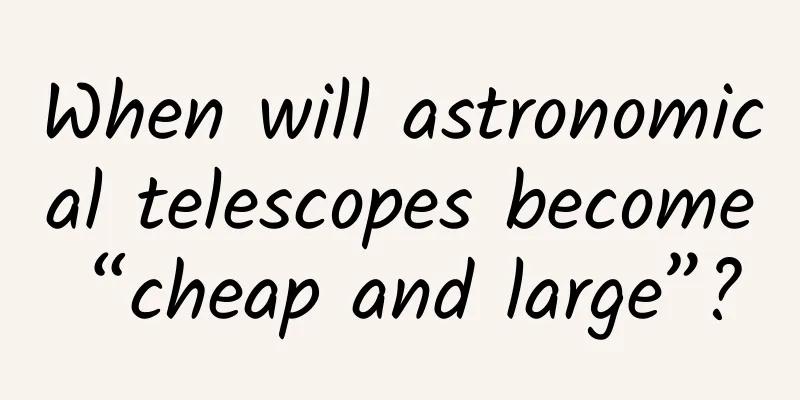When will astronomical telescopes become “cheap and large”?

|
Produced by: Science Popularization China Author: Salty Fish in the Sea (Master of Optics from Changchun Institute of Optics and Fine Mechanics, Chinese Academy of Sciences) Producer: China Science Expo First look at space As early as the Neolithic Age, ancient people drew patterns such as moon phases and constellations on some caves and stones. Since then, mankind has embarked on the most magnificent and exciting part of the journey of seeking knowledge - exploring the universe. In ancient times, astronomers observed the universe with their naked eyes, divided the stars into several groups, and gave them specific names, which are now known as constellations; they also established a magnitude system to measure the brightness of stars; people also observed the position and movement of the sun, moon and stars to divide the 24 solar terms to guide farming and life. After the advent of the telescope in the early 17th century, human beings' ability to observe the universe was greatly improved, which also promoted human beings' acceptance of the heliocentric theory. Bruno, an astronomer in the 16th century, was sentenced to death for supporting the heliocentric theory. If the telescope had been invented when Bruno lived, more people might have supported him. Early 17th century telescope (Image source: Wikipedia) The race for space observation The invention of the telescope solved the problem from 0 to 1, and the next step is to continuously improve its performance. There is a key indicator for evaluating the performance of a telescope - the aperture . The aperture is the diameter of the telescope's primary mirror. The larger the aperture, the more light the telescope can collect, and the brighter and clearer the celestial bodies observed. For example, when you observe stars directly with your naked eye, they often appear dim and blurry. Observing with a telescope will reveal that the stars become brighter and more detailed. This is because the aperture of the telescope is much larger than the diameter of the human eye pupil (under dark conditions, the pupil diameter is about 8mm), and it can collect more light than the naked eye. In 1671, Newton invented the reflecting telescope, which used a reflector instead of a lens to obtain a clearer image and a wider field of view. With a direction to work towards, everyone rushed on the road to pursuing large-aperture telescopes. William Herschel (who discovered Uranus with the help of a telescope in 1781) built a telescope with a diameter of 1.26 meters in 1789; George Ellery Hale built the Hooker telescope with a diameter of 2.5 meters with the support of John Hooker, Andrew Carnegie and others. Edwin Hubble used the Hooker telescope to observe the universe and came to two conclusions that changed the scientific community's view of the universe: there are galaxies outside the Milky Way, and the universe is expanding. William Herschel's 1.26-meter-diameter telescope (Image source: Wikipedia) Hooker telescope, diameter 2.54 meters (Image source: Wikipedia) In modern times, large-aperture telescopes have sprung up like mushrooms after a spring rain. The Hale Telescope built in 1948 has a diameter of 5.08 meters; the Keck I Telescope built in 1993 has a diameter of 10 meters; the GTC Telescope built in 2007 has a diameter of 10.4 meters, making it the largest optical telescope in the world. GTC telescope, 10 meters in diameter (Photo credit: Flickr/Pedro José Luengo Rarmírez) Behind the powerful performance of the telescope is a high cost Large-aperture telescopes have promoted the development of astronomy and expanded human knowledge of the universe. However, there is a problem that always accompanies large-aperture telescopes: cost. Building a large-aperture telescope is too expensive. William Herschel built a 1.26-meter-diameter telescope with royal sponsorship. It took Herschel five years to complete it and exceeded the budget. Most modern and contemporary large telescopes are built with the support of one or several countries. The Keck 1 telescope cost about $870 million, and the GTC telescope cost as much as $1.47 billion. These telescopes are basically used by professional astronomical research institutions. For most people, the astronomical telescopes they can access are mostly 15 cm to 30 cm in diameter, and their prices range from several thousand to tens of thousands of yuan. However, the price of a 50 cm diameter telescope has soared to nearly 400,000 yuan. Saturn observed through telescopes of different apertures (Image source: NASA, hubblesite) As shown in the picture above, the larger the telescope's aperture, the more details of Saturn can be observed. A 10-centimeter telescope cannot observe the Cassini Division (the gap in Saturn's rings), but a 20-centimeter telescope can clearly distinguish it. The 2.4-meter Hubble telescope can clearly capture the distribution of details of Saturn's rings. This also means that when observing other areas of the sky, the larger the telescope's aperture, the higher the resolution, and the more stars that can be observed. Thin-film telescopes take a different approach Seeing the twinkling stars with your own eyes is better than any galaxy picture displayed on the screen. If there is a telescope with a large aperture and affordable price, it must be a membrane telescope. As its name suggests, the mirror in a membrane telescope is not made of metal or glass, but a reflective film. How to use a film to make a reflective mirror? Let me explain it with a simple little experiment. Cut off the flat bottom of a mineral water bottle and cover it with a layer of plastic wrap or other elastic film, then blow or inhale into the bottle mouth. At this point, you have mastered the principle of making a membrane reflector. When you exhale or inhale into the bottle, the plastic wrap will be bent into a concave or convex surface due to the pressure difference between the inside and outside of the mineral water bottle. In addition to using air pressure to control the shape of the film, static electricity can also be used to control the shape of the film. In winter, the static electricity on people's hands can attract hair to stand up. Similarly, using static electricity to attract the film can also make the film deform into the shape we need. Image: Electrostatically controlled thin film mirror (Image source: Reference 2) In the 1960s, the United States launched an inflatable satellite Echo-1 with a diameter of 30 meters. It was like a large reflective balloon, which was the earliest engineering application of thin film reflectors. However, due to the technical limitations at the time, the actual surface shape of this "big balloon" did not meet people's expectations, but its existence laid the foundation for a series of subsequent studies on thin film reflectors. After decades of development, Boeing, NASA, Changchun Institute of Optics and Fine Mechanics of the Chinese Academy of Sciences, Soochow University and other research institutions have mastered the processing and manufacturing technology of thin film telescopes. At present, thin film reflectors can be used for optical imaging. Moon images taken with a thin-film telescope (Image source: Reference 3) The future is bright, but the road is difficult When using thin film mirrors to make astronomical telescopes, the main cost is no longer the thin film mirror itself, but the supporting mechanism for controlling the deformation of the film. The mechanism for controlling the deformation of the film by electrostatics or air pressure needs to be precise enough to ensure that the film is bent into an ideal shape, and it also needs to react quickly enough. Flexible thin film mirrors are easily affected by the outside world. The flow of air and even temperature changes can change the shape of the film. Therefore, a sensitive and precise surface control mechanism and supporting control algorithms are the key to the performance of thin film mirrors. Although the algorithm itself is complex, the cost of replicating and applying it on a large scale is quite low. According to conservative estimates, the cost of a thin-film reflecting telescope with an aperture of about half a meter can be controlled at about 10,000 yuan, which is enough for many ordinary people to buy one and provide everyone with a window to glimpse the world outside the earth. References: [1] Caicoya, P. & Barreto, M. & Fernández-Izquierdo, Patricia & Patron, Jesus & Sanchez de la Rosa, Vicente & Sangines, F.. (2014). From 1.5 Meters to 10.4 Meters in 20 Years: Technological Evolution at the Instituto de Astrofísica de Canarias in the Development of Infrared Instrumentation for Terrestrial Telescopes. Journal of Astronomical Instrumentation. 03. 1450005. [2] Zhang Peng, Jin Guang, Shi Guangfeng, et al. Research and development status of space film mirrors[J]. Chinese Journal of Optics and Applied Optics, 2009(2):11. [3] Angel M, Engineering S, Societyaasus AA, et al. Eight-inch f5 deformable magnetic-membrane mirror[C]// Conference on Optomechanical Technologies for Astronomy. 2006. [4] Zhang Xuejun, Fan Yanchao, Bao He, et al. Application and development of ultra-large aperture space optical remote sensors[J]. Optics and Precision Engineering, 2016, 24(11):14. [5] Zhang Ying, Jin Guang. Research on the electrostatic forming mechanism of thin film mirrors[J]. Optics and Precision Engineering, 2009, 17(2). [6] GTC Telescope Official Website |
<<: "China's Sky Eye" has made new discoveries!
>>: Can humans really achieve immortality? Let's start with HeLa cells
Recommend
They were in their prime that year... Salute to their youth!
Be determined to serve the country and write a st...
Ford F-150 hybrid version does not provide EV mode, endurance becomes a bottleneck
Recently, overseas media reported that Ford CTO (...
In Zhaosu, Xinjiang, be a "rainbow chaser"
The rainbow has been a symbol of beauty since anc...
Some people are made of water, some people are made of tears
Some people are made of water, some people are ma...
Smart home appliances become a dark area of security issues. Amazon Echo hacking once again rings the alarm bell for the industry
Amazon has slammed the brakes on the global smart...
I start drooling when I pass by a bakery. Is that tempting aroma fake?
Whenever I pass by a bakery, I always smell a fra...
What is the focus of content operations? One picture tells you!
Without further ado, the whole article is structu...
The only thing standing between Alibaba Music and a world-class music organization is Gao Xiaosong?
News of a personnel change indicates that the onl...
Zuckerberg's New Year's resolution: Let artificial intelligence control the home environment
[[161183]] Facebook CEO Mark Zuckerberg wrote on ...
The chicle tree is in bloom, and the smell is intoxicating!
There is a kind of green tree on the streets of H...
The latest cocktail party guide for ChinaJoy 2016 is here! (102 events updated at any time)
The annual ChinaJoy will be held in Shanghai from...
618. How to monitor the Double Eleven promotional activities?
Every year’s 618 is very special. At that time, a...
How to use JD E-card?
1. Use JD E-card can only be used to purchase pro...
Why do I feel like there are fewer mosquitoes this year? Is it because of the hot weather? The truth is…
Many people feel that there are fewer mosquitoes ...
What are the common http status codes?
For those who have just started SEO website optim...









